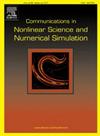基于节点和边缘信息的复杂网络重要节点识别
IF 3.8
2区 数学
Q1 MATHEMATICS, APPLIED
Communications in Nonlinear Science and Numerical Simulation
Pub Date : 2025-07-15
DOI:10.1016/j.cnsns.2025.109116
引用次数: 0
摘要
针对之前重要节点的定义,从资源分配的角度重新定义重要节点,提出了一种新的重要节点识别算法——有效距离-结构孔边(Effective Distance-Structural Hole-Edges, DSE)。该算法利用有效距离来表示资源分配,结合“洞”的数量(即中间位置的数量)和边的重要性(其中K-shell算法从识别节点扩展到识别边)。通过SIR模型在9个真实网络和构建网络中的仿真实验,分析了DSE和6个常用中心性指标识别重要节点的性能。最后,利用Kendall 's tau相关系数和M(R)指标分析了DSE算法的可行性。实验结果表明,在9个网络和构建的网络中,DSE识别出的top-1%和top-5%的节点几乎具有最高的感染节点能力。Kendall’s tau相关系数均为正相关,M(R)值均大于0.99。这表明本文中重要节点的定义是真实的,DSE算法可以有效地评估节点的重要性。本文章由计算机程序翻译,如有差异,请以英文原文为准。
Identification of important nodes in complex networks based on node and edge information
Aiming at the previous definition of important nodes, important nodes are redefined from the perspective of resource allocation and a new algorithm of identifying important nodes, DSE (Effective Distance-Structural Hole-Edges), is proposed. This algorithm utilizes the effective distance to represent the resource allocation, combines the number of ”holes” (i.e., the number of intermediary positions) and the importance of edges (where the K-shell algorithm is extended from identifying nodes to identifying edges). The performance of DSE and six commonly used centrality indicators in identifying important nodes is analyzed by using the SIR model simulation experiments in the nine real networks and the constructed networks. Finally, the feasibility of DSE algorithm is analyzed by using the Kendall’s tau correlation coefficient and the M(R) index. The experimental results show that the top-1% nodes and top-5% nodes identified by DSE have almost the highest ability to infect nodes in both the nine networks and the constructed networks. Additionally, the Kendall’s tau correlation coefficients are all positively correlated, and the M(R) values are all above 0.99. These show that the definition of important nodes in this paper is realistic and the DSE algorithm can effectively evaluate the importance of nodes.
求助全文
通过发布文献求助,成功后即可免费获取论文全文。
去求助
来源期刊

Communications in Nonlinear Science and Numerical Simulation
MATHEMATICS, APPLIED-MATHEMATICS, INTERDISCIPLINARY APPLICATIONS
CiteScore
6.80
自引率
7.70%
发文量
378
审稿时长
78 days
期刊介绍:
The journal publishes original research findings on experimental observation, mathematical modeling, theoretical analysis and numerical simulation, for more accurate description, better prediction or novel application, of nonlinear phenomena in science and engineering. It offers a venue for researchers to make rapid exchange of ideas and techniques in nonlinear science and complexity.
The submission of manuscripts with cross-disciplinary approaches in nonlinear science and complexity is particularly encouraged.
Topics of interest:
Nonlinear differential or delay equations, Lie group analysis and asymptotic methods, Discontinuous systems, Fractals, Fractional calculus and dynamics, Nonlinear effects in quantum mechanics, Nonlinear stochastic processes, Experimental nonlinear science, Time-series and signal analysis, Computational methods and simulations in nonlinear science and engineering, Control of dynamical systems, Synchronization, Lyapunov analysis, High-dimensional chaos and turbulence, Chaos in Hamiltonian systems, Integrable systems and solitons, Collective behavior in many-body systems, Biological physics and networks, Nonlinear mechanical systems, Complex systems and complexity.
No length limitation for contributions is set, but only concisely written manuscripts are published. Brief papers are published on the basis of Rapid Communications. Discussions of previously published papers are welcome.
 求助内容:
求助内容: 应助结果提醒方式:
应助结果提醒方式:


